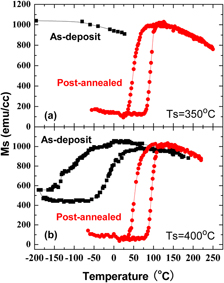Article contents
Effect of substrate temperature on the crystallographic structure and first-order magnetic phase transition of FeRh thin films
Published online by Cambridge University Press: 03 April 2013
Abstract

In this article, the effects of substrate temperature on the crystallographic structure and first-order magnetic phase transition in iron-rhodium (FeRh) thin films are investigated. It was found that for the as-deposited FeRh thin films, 350–400 °C is the optimal range of substrate temperature for obtaining B2 ordered FeRh thin films. After postannealing, it was shown that 400 °C is the optimized substrate deposition temperature for obtaining the best chemical/atomic ordering in postannealed FeRh thin films. Magnetization studies indicate that the as-deposited FeRh thin film with substrate temperature of 350 °C does not show a first-order antiferromagnetic (AFM)- to-ferromagnetic (FM) phase transition behavior during heating process and it gives a typical FM behavior whereas the as-deposited FeRh thin film deposited at 400 °C shows a broad first-order AFM-to-FM phase transition during heating and cooling processes. Both the postannealed FeRh thin films deposited at 350 and 400 °C give a clear first-order AFM-to-FM phase transition with a residual magnetization of about 50–100 emu/cc. The residual magnetization may possibly be caused by the disordered bcc (α) FM phase, B2 ordered (α′) FM phase or a near-surface/interfacial ferromagnetism in the ordered FeRh thin films.
- Type
- Articles
- Information
- Copyright
- Copyright © Materials Research Society 2013
References
REFERENCES
- 9
- Cited by




